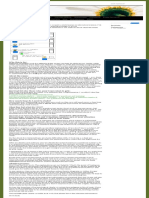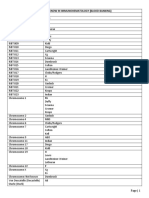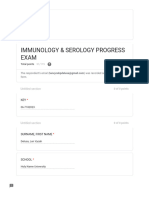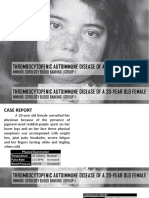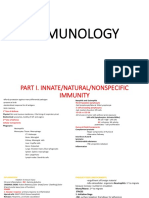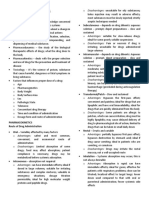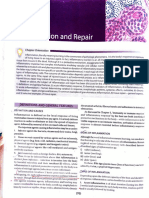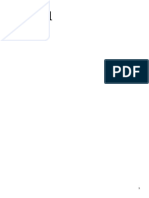100%(2)100% found this document useful (2 votes)
190 viewsImmunology & Serology: Preliminaries: Romie Solacito, MLS3C
Immunology & Serology: Preliminaries: Romie Solacito, MLS3C
Uploaded by
Romie SolacitoThis document discusses the history and development of immunology and vaccination. It describes how exposure to cowpox provided protection against smallpox, leading Edward Jenner to develop the smallpox vaccine in 1796. It also discusses other milestones like Louis Pasteur's development of attenuated vaccines for chicken cholera, rabies, and anthrax in the late 1800s. Finally, it provides an overview of the innate and adaptive immune system, including cellular and humoral immunity.
Copyright:
© All Rights Reserved
Available Formats
Download as DOCX, PDF, TXT or read online from Scribd
Immunology & Serology: Preliminaries: Romie Solacito, MLS3C
Immunology & Serology: Preliminaries: Romie Solacito, MLS3C
Uploaded by
Romie Solacito100%(2)100% found this document useful (2 votes)
190 views12 pagesThis document discusses the history and development of immunology and vaccination. It describes how exposure to cowpox provided protection against smallpox, leading Edward Jenner to develop the smallpox vaccine in 1796. It also discusses other milestones like Louis Pasteur's development of attenuated vaccines for chicken cholera, rabies, and anthrax in the late 1800s. Finally, it provides an overview of the innate and adaptive immune system, including cellular and humoral immunity.
Original Description:
UIC - MLS: Immuno-Serology
Original Title
Immuno-Serology Preliminaries
Copyright
© © All Rights Reserved
Available Formats
DOCX, PDF, TXT or read online from Scribd
Share this document
Did you find this document useful?
Is this content inappropriate?
This document discusses the history and development of immunology and vaccination. It describes how exposure to cowpox provided protection against smallpox, leading Edward Jenner to develop the smallpox vaccine in 1796. It also discusses other milestones like Louis Pasteur's development of attenuated vaccines for chicken cholera, rabies, and anthrax in the late 1800s. Finally, it provides an overview of the innate and adaptive immune system, including cellular and humoral immunity.
Copyright:
© All Rights Reserved
Available Formats
Download as DOCX, PDF, TXT or read online from Scribd
Download as docx, pdf, or txt
100%(2)100% found this document useful (2 votes)
190 views12 pagesImmunology & Serology: Preliminaries: Romie Solacito, MLS3C
Immunology & Serology: Preliminaries: Romie Solacito, MLS3C
Uploaded by
Romie SolacitoThis document discusses the history and development of immunology and vaccination. It describes how exposure to cowpox provided protection against smallpox, leading Edward Jenner to develop the smallpox vaccine in 1796. It also discusses other milestones like Louis Pasteur's development of attenuated vaccines for chicken cholera, rabies, and anthrax in the late 1800s. Finally, it provides an overview of the innate and adaptive immune system, including cellular and humoral immunity.
Copyright:
© All Rights Reserved
Available Formats
Download as DOCX, PDF, TXT or read online from Scribd
Download as docx, pdf, or txt
You are on page 1of 12
IMMUNOLOGY & SEROLOGY: PRELIMINARIES o Variola Minor – mild form of smallpox
Romie Solacito, MLS3C (a.k.a. Alastrim, Cuban itch, cottonpox,
INTRODUCTION milkpox, whitepox).
Pathogens: Fungi, Parasite, Bacteria, Virus, Carcinogen, The term “Smallpox” was first used in Europe in
& Pollution the 15th Century to distinguish first from the
Two Types of Immune System “greatpox”/syphilis – causative agent:
1. Innate/Natural – is the ability of the individual to Treponema pallidum subsp. pallidum.
resist infection by means of normally present Variolation – exposure to a material coming
body functions; do not possess immunologic from a manifested material of infection/disease
memory or no prior exposure required. (example: “smallpox” lesion).
2. Adaptive/Acquired – is a type of resistance that Chinese (A.D. 1500) – developed a custom of
is characterized by specificity for each individual inhaling powdered crust from smallpox lesion.
pathogen and the ability to remember a prior 1718, Lady Mary Wortly Montagu (wife of
exposure = increased response upon repeated British Ambassador to Turkey) – introduced
exposure; POSSESS IMMUNOLOGIC MEMORY variolation to Europe; inserting smallpox lesion
Immunology – the study of a host’s reaction when under the skin.
foreign substance are introduced into the body; the Further refinements did not occur until the late
medically related consequences that arise when 1700s – English doctor discovered a remarkable
these mechanisms either fail or respond in an relationship…
exaggerated form; eliminate non-self-components Edward Jenner (1700s) – Introduce the Cross-
such as infectious agents Immunity. It is a phenomenon in which exposure
Antigen – a foreign substance that induces such as to one agent produces protection against
immune response; Macromolecules that are capable another agents.
of eliciting formation of immunoglobulin or o Cowpox (mild in cow) and Smallpox has
sensitized cells in an immunocompetent host. the same antigenic structure.
Immunogens – Any substance that can induce an May 14, 1796, Inoculated matter from “cowpox”
immune response; all immunogens are antigen, but lesion to an 8-year-old boy, James Phipps. The
all antigens are not immunogen.
boy developed cowpox infection (mild form) –
Immunological Tolerance – the failure to mount an
the next day the boy gets better.
immune response to an antigen. This is the failure (a
July 1796 – Jenner inoculated with matter from
good thing to attack the body’s own protein and
fresh smallpox lesion – no disease developed.
other antigens).
Vaccination – from the Latin word “vacca”
Immunity – condition being resistant to infection.
means “cow”. Injection of cellular material to
induce immunity. Cowpox – causative agent:
SIGNIFICANT MILESTONES
Cowpox virus (member of Orthopoxvirus);
Thucydides – described a phenomenon where
Naturally a disease of cows
individual who recovered from a certain diseases
Louis Pasteur (Father of Immunology) –
rarely contracted with the same disease again.
Attenuation, achieve by heating. To change; to
weaken = antigen.
Role of “Smallpox - Variola” in the development of
o Develop vaccines against:
Immunology
Chicken Cholera
Rabies
Smallpox- caused by two virus variants:
Anthrax – causative agent: Bacillus
o Variola Major – serious form of smallpox
anthracis.
Variolation & Vaccination – these two
procedures were successful in decreasing
smallpox mortality. World Health Organization o Innate Immunity – natural and non-specific
declared its totality eradication in 1979. o Adaptive Immunity – acquired and specific
IMMUNE SYSTEM: INNATE
Cellular Immunity vs. Humoral Immunity o Refers primarily to anatomical, humoral and cellular
defense that function in the early stages of host
Elie Metchnikoff (1880-1900) – phagocytosis “eating defense in response to foreign substances.
cells”; macrophage and microphage (Cellular o Block or limit access to the body (i.e. physical
Immunity) barriers)
o Phagocytosis – a process of which a cell o Innate activation of immune mechanism (humoral
“leukocytes” is capable of engulfing or “eating” and cellular)
another cells o DO NOT POSSESS IMMUNOLOGIC MEMORY
Emil Von Behring & Shibasaburo Kitasato (1890) – o Non Adaptive – no prior exposure required; response
antibodies (Humoral Immunity), protective factors in does not change with subsequent exposure.
the blood and other body fluids. From Plasma Cells o Non Specific – Same for all foreign substance to
from B-Cells, Specific factor; acts only to a certain which one is exposed.
antigen. Innate Immunity influenced by the following factors:
Almoth Wright – Cellular & Humoral Immunity Nutrition
Age
CELLULAR IMMUNITY V HUMORAL IMMUNITY Fatigue
Stress
Cellular Immunity – Immune Cells: Genetic determinants
o White Blood Cells (BENML) Innate mechanism includes:
o Dendritic Cells External – 1st line of defense.
o NK Cells a. Anatomical barrier
o Mast Cells b. Resident flora
Basophil – histamine c. Physiological factors
Eosinophil – parasitic reaction Internal – 2nd line of defense.
Neutrophil – bacteria reaction a. Humoral factors
Monocyte & Leukocyte – virus & fungi b. Cells
Humoral Immunity – Immune response involving EXTERNAL DEFENSE
antibodies (Ab). I. Anatomical Barrier
THE IMMUNE SYSTEM a. Skin – keratinization and constant renewal of
It is composed of wide array of cells, soluble the skin’s epithelial cells assist in the protective
molecules, & tissues with the following function of the skin.
characteristics: i. Staphylococcus epidermidis – releases
o Specificity Phenol Soluble Modulin acts as Antimicrobial
o Memory Peptide that fight other organism.
o Mobility b. Secretions
o Replicability i. Mucus – adhering the nose and nasopharynx
o Cooperation between different cells or cellular ii. Sebum – consists of lactic and fatty acids
products maintain the pH (3-5) of the skin inhibits the
T-Cells – use for the antigen presentation, the one growth of microorganisms.
who releases lymphokines. c. Earwax – protect auditory canal from infection;
Primary Role: Surveillance and destruction of targets the gram positive organism.
substances that are foreign to the body (tolerance). i. Lysosomes – attack cell wall of microbes,
Two Categories of Immune System: especially gram positive bacteria; it digest
the β (1-4) glycosidic bond between NAM b. Complement System – Series of Serum Protein
and NAG. in immediate inflammation.
d. Saliva, Tears, Mucous Secretions – wash away c. Cytokines – substances release as messengers
potential invaders and also contain for general.
antibacterial and antiviral substances. II. Cellular Factors
e. Cilia – hair like protrusions of the epithelial cell a. White Blood Cells: Neutrophil, Eosinophil,
membranes; the synchronous movement of Basophil, Lymphocyte, and Monocyte
cilia propels mucus – entrapped INFLAMMATION
microorganisms from these tracts. The overall reaction of the body to injury or invasion
f. Elimination of liquid and substances by certain infectious agent.
i. Urination 1. 1st Objective: localize and eradicate irritant and
ii. Defecation repair the surrounding tissue.
iii. Coughing 2. Stages:
iv. Sneezing Vascular Response
g. Acidity – vaginal (lactic acid) pH 5; stomach Cellular Response
(hydrochloric acid) pH 1 (H. pylori can survive). Resolution and Repair
II. Resident Flora – non-pathogenic organisms in some Five Cardinal Signs of Inflammation
parts of the body. Lactobacillus acidophilus 1. Heat/Calor
III. Physical Factors: 2. Redness/Rubor
a. Body temperature 3. Pain/Dolor
b. Oxygen tension 4. Swelling/Tumor
c. Hormonal imbalance 5. Loss of Function/Fuctio Laessa
d. Age Cause of Chemical mediator, histamine
INTERNAL DEFENSE STAGES OF INFLAMMATION
I. Humoral Factors I. Vascular Response
a. Acute Phase Reactants a. Vasodilation – 1st immune response; increases
blood flow to injured site (Hyperemia –
Redness/Rubor); increases capillary permeability Acute Phase Reactant
(Plasma leakage to tissue – Tumor and Dolor). Group of glycoproteins associated with acute phase
II. Cellular Response response
a. Chemotaxin – chemical messenger for Rise at different rates and in varying levels in
chemotaxis response to injury
b. Neutrophils – used for acute inflammation Increased shortly after trauma
c. Monocytes – transform into macrophage if they Initiated and sustained with pro-inflammatory
are in tissues; used for chronic inflammation; cytokines
Antigenic Presenting Cell; APR: Synthesis
i. secretes monokines – calls the other Synthesized rapidly in response to tissue injury
monocytes Produced primarily by hepatocytes within 12-24hr in
d. IL -1 response to tissue injury.
o Hypothalamic Fever Elevated 2 to 5 fold in certain diseases.
o Increase in APRs Stimulated by the following cytokines:
o Stimulates T-cells to produce IL-2; T-cells Interleukin-1β (IL-1β), interleukin-6 (IL-6), and
induces T-cell proliferation. tumor necrosis factor-alpha (TNF-α)
ACUTE PHASE REACTANTS Strenuous exercise – can trigger release of APRs
Biomarkers of inflammation C–Reactive Protein (CRP)
Elevated – Erythrocytes Sedimentation Rates – Trace constituent of serum
screening for inflammation Synthesized in the liver (stimulated by IL-6)
o Principles: measures the rate of Red Blood Cells Discovered by Tillet and Francis (1930)
to settle down at the bottom. Originally defined by its calcium dependent
Elevated – White Blood Cells precipitation with the C-polysaccharide of
Abnormal Serum Protein Electrophoresis – Pneumococcus
polyclonal gammopathy (low concentration of Useful indicator of disease states
Albumin and high concentration of Gamma). Physiologic role – binds to phosphocholine
Elevated Acute Phase Reactants – Two Types: (SUBSTRATE: common constituent of microbial
membrane)
o Positive Acute Phase Reactant – increase during
Activate the complement cascade
inflammation (i.e. C-RP, Mannose Binding
Outstanding Characteristics:
Protein, Serum Amyloid A)
o Appears in sera of individuals in response to a
o Negative Acute Phase Reactant – decrease
variety of inflammatory conditions
during inflammation (i.e. Albumin, Transferrin, o Dramatic increase in concentration
and Antithrombin) o Disappears when inflammation subsides
o Appears rapidly after the onset of disease
o May increase 1000x its normal amount
o The fastest responding and most sensitive
indicator of inflammation
o Increases faster than ESR in responding to
inflammation
o Leukocyte count may remain within normal
limits despite infection
Properties:
o MW = 118 - 120,000 daltons
o Sedimentation rate = 6.5
o Electrophoretic mobility = gamma region
o Composed of 5 identical subunits approximately damage and in preventing the loss of iron by urinary
21,500 – 23,500 Da each linked in the form of a excretion.
cyclic pentamer Provide protection against oxidative damage
o 100% protein with amino acids similar to mediated by free hemoglobin, a powerful oxidizing
immunoglobulins agent that can generate peroxides and hydroxyl
o CRP requires Calcium radicals
o Physical properties Fibrinogen
o Thermo-labile (destroyed at 70oC for 30 Accumulates at site of injury
minutes) Converted to fibrin; Hastens wound healing process;
o Does not cross the placenta Stimulates fibroblast proliferation and growth
o Elevation of CRP above normal Ceruloplasmin (Copper Transporting Protein)
o Indicates tissue damage and/or inflammation The liver normally takes copper from the
Current & Potential Uses: bloodstream and puts it into ceruloplasmin proteins.
o The first to increase in presence of active The ceruloplasmin is then released into blood
inflammation plasma.
Onset: 4-6 hours Ceruloplasmin carries copper around your body to
Peak levels: 48 hours (M: 1.5 mg/L; F: 2.5 the tissues that need it.
mg/L) α-2 macroglobulin
Half-life: 19 hours Inhibitor of proteinases involved in inflammatory
Decrease after postoperative day/recovery reactions.
period
Can be used to correlate with (ESR, WBC COMPLEMENT SYSTEM
count, SPE) Series of serum proteins that are normally present
Serum Amyloid A and whose overall function is mediation of
Synthesized in the liver inflammation.
Molecular weight of 11,685 daltons Interacts in a specific way to enhance host defense
Normal circulating levels are approximately 30ug/ml First described by Paul Erlich
Associated with HDL cholesterol
Major role: promotes opsonisation & lysis of foreign
Functions of Serum Amyloid A:
substance
o Helps in removing cholesterol from cholesterol-
Heat–labile series of more than 30 soluble plasma
filled macrophages in tissue injury
proteins
o Involved in the cleaning up of the injured area.
o Some are enzymes or proteinases
o Facilitates recycling of cell membrane
o Major fraction of beta globulins
cholesterol and phospholipids for reuse in
Part of the humoral component of the Innate
building membranes of new cells required during
immune system
acute inflammation
Alpha 1-antitrypsin o Participates in the INFLAMMATORY RESPONSE
Nomenclature
Inhibits leukocyte proteases
Comprises 90% of α1 – globulin band Capital “C” and a “#” – Example: C1
Prevents proteases from initiating tissue damage Small letter after the number – Example: C4b
Deficiency: Emphesymatous pulmonary disease; o Indicated that the protein is smaller portion of a
Juvenile hepatic disorders large precursor as a result of cleavage by
Haptoglobin protease
MW – 100,000 daltons; α2 - electrophoretic o Larger – “b” except C2b
mobility; Irreversibly binds to free hemoglobin o Smaller – “a” except C2a
Increase two – four folds Complement System
Found in inflammatory processes; Plays an There are 9 major complement components involve
important role in protecting the kidney from in the activation. Most are produced in the liver
except C1 (produced by intestinal epithelial cell) and o C5a is released into the body fluids where it
Factor D (produced by adipose tissues) acts as an ANAPHYLATOXIN and
Macrophages and Monocytes – additional sources of CHEMOTAXIN
C1, C2, C3, & C4 o C5b activates C6 and C7
The rest of the components – acts as stabilizers and SECOND MEMBRANE ATTACK UNITS: C6 and C7
control proteins and proteases o C6 binds to C5b thereby stabilizing it
Jules Bordet – discovered Complement o This complex then attaches to cell surface
THREE COMPLEMENT PATHWAYS o C7 binds next, forming a trimolecular
1. Classical Pathway complex which allows insertion of C7 part of
Recognition Unit – C1 molecule (C1q, C1r, and the C5b67 complex into the membrane of
C1s); Interlocking enzyme system; stabilized by the target cell.
Calcium Ions FINAL MEMBRANE ATTACK UNITS: C8 and C9
Requirement for activation o C8 binds to C7 and forms a small hole in the
o Antibody and antigen interaction membrane of the target cell
o Complement binds to CH2 domain o The pore formed by the binding of C5b678 is
o All IgM and IgG can fix complement small, capable of lysing RBCs but not
o Needs at least 2 monomers of IgG attached nucleated cells
to target cell o For lysis of nucleated cells to be achieved, C9
First Activation Unit: C4 must bind to the complex
o C1s activates C4 Note: Anaphylatoxins – C4a, C3a, and C5a; Opsonins –
o C4 releases C4a and C4b (excess C3b); Most potent chemotaxin – C5a; C1 Inhibitor
o C4a plays no role in the complement cascade (C1INH) – dissociates C1r and C1a from C1q)
o C4b attaches to receptors on RBCs, bacterial IgG3 – most efficient Ig that activates
cell membranes and other antigens complement
SECOND ACTIVATION UNIT: IgM – pentameric
o C1s also activates C2 after its interaction Initiator – Antibody and antigen combination
with C4 recognition
o When combined with C4b, C2 releases C2a Anaphylotoxins – increases vascular
and C2b permeability and can cause edema, swelling and
o C2a binds to C4b in the presence of inflammation.
MAGNESIUM (Mg++) to form C4b2a (C3 Opsonins – helps in coating foreign substance –
convertase) excess C3b
o C2b is labile and decays rapidly Antibody – binds to epitope of cell membrane of
THIRD ACTIVATION UNIT: C3 the antigen/microorganism.
o C3 is the most abundant complement C3 – central molecule of Complement activation
component pathways. It is also the major constituent of the
o C3 converts splits C3 into C3a and C3b complement system and is present in the plasma
o C3b combines with C4b2a to form C4b2a3b at a concentration of 1200ug/mL
(C5 convertase) Pivotal point for all three pathways – cleavage of
o Represents the most significant step in the C3 to C3b represents the most significant step in
entire process the entire process of complement activation
o C3b also serves as a powerful opsonin 2. Alternative Pathway or Properdin (Stabilizer)
FIRST MEMBRANE ATTACK UNIT: C5 Lipopolysaccharide
o C5 convertase cleaves C5 into C5a and C5b Bypasses C1, C4, & C2
C3 – activates at slow rate by water and plasma
enzymes. Activated at slow rate celllysis due to
increased water and permeability by osmotic 3. Mannose Binding Lectin (binds to Carbohydrates)
pressure plasma enzymes Pathway
Factor D – cleaves Factor B Initiated by microorganisms with mannose or
C3b – binds to Factor B similar sugars in the cell wall or outer membrane
Summary: aggregates of IgA, and IgG4; Yeast cell MASP – Mannose binding Lectin Associated
wall or zymosan; LPS; bypasses C1, C4, and C2 Serine Protein
MASP-1 activates MASP-2 that cleaves C4 and C2
MLB – same to C1q
Complement Regulatory Proteins
1. C1 Inhibitors (C1INH) - Controls activity of C1; Binds
to C1 and can dislodge; Bound C1 to immunoglobulin
– C1 activation is halted
2. Factor I - Inhibitor of C4b – cleaves C4b to C4c and
C4d
3. C4 binding protein (C4BP) – destroys bound C4b and
can also displace C2a from the classical pathway C3
Convertase C4b2a
4. Inhibitors of C3 Convertase Formation - Factor I
inactivates C4b and C3b – converts C3b to iC3b;
requires Factor H as cofactor; Factor H and C4b
dissociates C3 Convertases of both classical and
alternative pathways
Regulation of MAC
S Protein (Vitronectin) – binds the C5b-7 Complex,
thereby preventing its insertion in the cell
membrane forms C5b-9 complex
Clusterin – also called Sp40 or apolipoprotein; Gelatinase
prevents insertion of the C5b-7 complex into the cell Plasminogen activator
membrane (similar function of S Protein) Acid hydrolases
Regulatory Proteins – species specific Normally, half of the total neutrophil population is
Disease Component found in a marginating pool on blood vessel walls,
C1 – Lupuslike Syndrome; Recurrent Infection while the rest circulate freely for approximately 6 to
C2 – Lupuslike Syndrome; Atherosclerosis, 10 hours.
Recurrent Infection Eosinophils
C3 – Glomerulonephritis; Severe Recurrent 12 to 15um in diameter, and they normally make up
Infection between 1 to 3% in non-allergic person
C4 – Lupuslike Sundrome Their number increases in an allergic reaction or in
C5 to C8 – Neisseria infection; PID – pelvic; response to many parasite infections
Waterhouse Friedrichson The nucleus is usually bilobed or ellipsoidal and is
C9 – No know Disease often eccentrically located
C1-INH – Hereditary Angioedema Primary Granules
Factor H & Factor I – Recurrent Pyogenic o Acid phosphatase
Infection o Arylsulfatase
IMMUNE CELLS – The second line of defense o Eosinophil-specific granules (Major basic
Cellular Defense Mechanism protein, Eosinophil cationic protein, Eosinophil
Leukocytes or White Blood Cells in peripheral blood: peroxidase, Eosinophil-derived neurotoxin)
Neutrophil, Eosinophil, Basophil, Monocyte, and These cells are capable of phagocytosis but are much
Lymphocyte. less efficient than neutrophils.
Neutrophil Their most important role is neutralizing basophil
Polymorphonuclear Neutrophilic (PMN) Leukocyte and mast cell products and killing certain parasites.
Represents approximately 50 to 70 percent of the Mechanism of Action – Parasite Killing
total peripheral white blood cells. o Does not recognize helminths directly, rather via
These are around 10 to 15um in diameter, with a intermediary molecule, IgE antibody bound to
nucleus that has between two and five lobes. the helminth.
They contain a large number of neutral staining o Has FcƐR
granules (pink), which are classified as primary, Basophil
secondary, and tertiary granules. Less than 1 percent of all circulating leukocytes
o Primary Granules or Azurophilic Granules The smallest of the granulocytes, they are between
Myeloperoxidase 10 to 15um in diameter and contain coarse, densely
Elastase – damage host tissue staining deep-bluish purple granules that often
Proteinase 3 obscure the nucleus.
Lysozyme – use to target bacteria cell Constituents of these granules are histamine, a small
Cathepsin G amount of heparin, and eosinophil chemotactic
Defensins – increase membrane factor-A, all of which have an important function in
permeability inducing and maintaining immediate
o Secondary Granules hypersensitivity reactions.
Collagenase IgE, the immunoglobulin formed in allergic reactions,
Lactoferrin – use for Iron binding binds readily to basophil cell membranes, and
Lysozyme – use to target bacteria cell granules release their constituents when they
Reduced nicotinamide adenine dinucleotide contact an antigen.
phosphate (NADPH) oxidase
o Tertiary Granules
Mast Cells ORGANS MACROPHAGE
Resemble basophils, but they are connective tissue Liver Kupffer Cells
cells of mesenchymal origin. Lung Alveolar Macrophages
Widely distributed throughout the body and are CNS Microglial
larger than basophils, with a small amount around Fat Preadipocytes
nucleus and more granules. Kidney Mesangial
Long life span of between 9 and 18 months. Bone Osteoclast
The enzyme content of the granules helps to Blood Monocyte
distinguish them from basophils, as they contain acid Bone Marrow Promonocyte + Monocytes
phosphatase, alkaline phosphatase, and protease. Lymph Node Lymph Node Macrophage
Plays a role in hypersensitivity reaction by binding Spleen Splenic Macrophage
IgE, like basophil. Synovial Fluid Synovial A Cells
Monocytes Connective Tissue Histiocytes
The largest cells in the peripheral blood, with a
diameter that can vary from 12 to 22um. Dendritic Cells
One distinguishing feature is an irregularly folded or Resembles nerve cell dendrites, their main function
horseshoe-shaped nucleus that occupies almost ½ of is to phagocytise antigen and present it to helper T-
the entire cell’s volume lymphocytes (lymphoid organs) to initiate the
The abundant cytoplasm stains a dull grayish blue acquired immune response.
and has a ground-glass appearance due to the They are the most potent phagocytic cell in the
presence of fine dust-like granules tissue.
These granules are actually of two types, (1) contains PHAGOCYTOSIS
peroxidase, acid phosphatase, and arylsulfatase; The reason why cells of the Innate Immune System
this indicates that these granules are similar to the are consider to provide non-specific immunity is due
lysosomes of neutrophils. (2) Contain Beta- to the nature of their receptors
gluconidase, lysozyme, and lipase, but no alkaline The cells of the innate are able to recognize
phosphatase. destructive molecular structures that are
Digestive vacuoles may also be observed in the synthesized by foreign pathogens.
cytoplasm Toll-Like Receptors
They stay in peripheral blood for up to 70hours, and Toll is a protein originally discovered in the fruit fly
then they migrate to the tissues and become known Drosophila, where it plays an important role in
as macrophages. antifungal immunity in the adult fly.
Macrophages Very similar molecules as found on human
All tissue macrophages arise from monocytes, which leukocytes, and some non-leukocyte cell types, and
can be thought of as macrophage precursors there are called Toll-Like Receptors
As the monocyte matures into a macrophage, there The highest concentration of these receptors occurs
is an increase in endoplasmic reticulum, lysosomes, on monocytes, macrophages, and neutrophils
and mitochondria There are 11 slightly different TLRs in humans
Unlike monocytes, macrophages contain no Each of these receptor recognize a different
peroxidase. microbial product
They functions include microbial killing, tumorcidal Once a receptors binds to its, particular substance,
activity, intracellular parasite eradication, or ligand phagocytosis may be stimulated
phagocytosis secretion of cell mediators, and antigen Thus, they play an important role in enhancing
presentation. natural immunity
Macrophages have specific names according to their
particular tissue location
Phagocytes have Toll Like Receptors – natural
receptors that detects pathogen product
Primitive Pattern Recognition – recognizes
Carbohydrates and Lipids produced in
microorganism
Steps of Phagocytosis
o Physical contact between the Leukocyte and the
foreign particle
o Formation of Phagosome
o Fusion with cytoplasmic granules to form a
Phagolysosome and
o Digest and release
Phagocytosis
Direct Phagocytosis
o No need for opsonin
o Via Primitive Pattern Recognition Receptor
(PPRR) or Toll Like Receptor
o Engulfment
Indirect Phagocytosis
o Enhanced by oposonization
o Via opsonins: Antibody, Complement, and CRP
o Cell Surface Receptor; RCR, Complement
Physical contact occurs as neutrophils roll along until
they encounter the site of injury or infection
They adhere to receptors on the Endothelial Cell
Wall of the blood vessels and penetrate through to
the tissue by means of Diapedesis
The process is aided by Chemotaxis, where by cells
are attached to the site of inflammation by chemical
substance such as Soluble Bacterial Factors,
Complement, C-Reactive Protein.
Indirect Phagocytosis (L); Direct Phagocytosis (R) Chemotaxis – a change in the direction of movement
Oposonins – “to prepare for eating” and serum of a motile cell in response to a concentration
proteins that attached to a foreign substance and gradient of a specific chemical chemotaxins.
help prepare it for phagocytosis. o Positive – towards the stimulus
Phagocytic cells have receptors for antibodies and o Negative – away from the stumulus
for complement components, which aid in contact Chemotactic Factors: Antibodies, Complement
and in initiating ingestion. Fragments, Bacterial Factors, Chemotactic Cytokines
(without these chemotactic factors cell motion is Exocytosis – residual bodies containing indigestible
random) materials are excreted as waste
Digestion Cytopepsis:
o 1st Mechanism LYMPHOID SYSTEM
Granules in the phagocytic cytosol migrate – The key cell involved in the immune response is the
fused with the phagosome to form lymphocyte. Lymphocytes represent between 20 and
phagolysosome 40% of the circulating leukocyte.
Degranulation of neutrophil lead to releases These cells are unique, because they arise from a
of: hematopoietic stem cell and they are further
1. Lactoferrin – binds Iron differentiated in the primary lymphoid organs.
2. Lysozyme – Target bacterial cell Lymphocytes are segregated within the secondary
3. Defensin – increase membrane organs according to their particular functions. T-
permeability Lymphocytes are effector cells that serve a
4. Elastase – damage host tissues regulatory role and B-Lymphocytes produces
o 2nd Mechanism antibody.
Activation of Enzymatic Complex, NADPH Primary Lymphoid Organs
oxidase, present in the phagosome Bone Marrow
membrane via the Hexose monophosphate o All lymphocytes arise from pluripotential
pathway. hematopoetic stem cells that appears initially in
Respiratory Burst: Oxygen Radicals the yolk sac of the developing embryo and are
1. O2 – highly toxic to microorganism later found in the fetal liver.
2. H2O2 – an important bactericidal agent, o Assumes this role when the infant is born
more stable than the others o Main source of hematopoietic stem cells, which
3. HOCl – hypochlorite radical, a powerful develop into erythrocytes, granulocytes,
oxidizing agent. monocytes, platelets, and lymphocytes
o Lymphocyte precursors are further developed in
the primary lymphoid organs.
o Functions as the center for antigen-independent
lymphopoiesis.
o In humans, B cell maturation takes place within
the bone marrow itself.
Thymus
o T cells develop their identifying characteristics in
the thymus, which is a small, flat, bilobed organ
found in the thorax, or chest cavity, right below
the thyroid gland and overlying the heart.
o Diminishes in size, it is still capable of producing
T lymphocytes until at least the fifth or sixth
decade of life.
o Site of T Cell development; secretes Thymusin
(Facilitated proliferation and differentiation of
immature T Cells that migrates from the bone
marrow)
o Reticular structure of the Thymus (Capsule)
allows progenitor T-Lymphocyte from the bone
marrow to passes through.
o Cortex – Immature (Bone Marrow Derived) T Medullary T Cells, B Cells, and Macrophages
cells become thymocytes Outer Cortex – outruns macrophages,
o Medulla – contains mature T-cells; only 5 – 10% and Bcells
of the maturing Lymphocytes survive and leave Folicular dendritic cells are also present
the thymus. 90 – 95% die in the thymus. Tonsil – respond to pathogens entering the
respiratory and alimentary tracts
Secondary Lymphoid Organs Other Organs
Once differentiation occurs, Mature T and B Appendix – an additional location of Lymphoid
lymphocytes are released from the Bone Marrow Tissue
and the thymus and migrate to secondary lymphoid MALT – found in the GI, Respiratory and Urogenital
organs and become part of a recirculating pool.
Main contact of cells with foreign antigen takes
place: Spleen - bloodstream, Lymph Node - tissues,
Mucosa – Associated Tissue (MALT), Peyer’s Patches,
Appendix, Tonsils
Spleen
o The largest secondary lymphoid organ
o It is located in the upper-left quadrant of the
abdomen, just below the diaphragm and
surrounded by a thin connective tissue capsule.
o Large discriminating filter
o Splenic tissue can be divided into two main
types: Red Pulp (destroy old RBC) and White
Pulp (container B-cell that are not yet
stimulated by antigen).
o Responds First to intravenous particulate
antigens
o 50% B Lymphocyte and 30-40% T Lymphocyte
o Major site of Antibody production.
o Highly efficient organ - Contains Mature Naïve B
and T cells
Lymph Nodes
o Small encapsulated structure
o Located along lymphatic ducts and serve as
central collecting points for lymph fluid from
adjacent tissues.
o Lymphoid filters: found throughout the body
o High Endothelial Venules – passage way of
lymphocytes from the blood stream.
o Secondary Follicles consist of antigen-
stimulated proliferating B cells contains Plasma
Cells and Memory Cells (activated form of B
Cells).
Generation of B-cell memory is a primary
function of lymph nodes
Paracortex – contains mostly T Cells and
some macrophages.
You might also like
- Uveitis Fundamentals and Clinical PracticeDocument432 pagesUveitis Fundamentals and Clinical Practiceigorgul0112100% (2)
- Reviewer - Immunoserology - Part 1Document12 pagesReviewer - Immunoserology - Part 1Joshua Trinidad0% (1)
- Clinical Chemistry 3: EndocrinologyDocument21 pagesClinical Chemistry 3: EndocrinologyRomie Solacito100% (3)
- EXPT3-IMSELAB-Screening Test For Phagocytic EngulfmentDocument21 pagesEXPT3-IMSELAB-Screening Test For Phagocytic EngulfmentJulie Ann GarceraNo ratings yet
- Reviewer - Immunohematology - Part 1Document16 pagesReviewer - Immunohematology - Part 1Joshua TrinidadNo ratings yet
- Clinical Chemistry KeyNotes For Board ExaminationDocument12 pagesClinical Chemistry KeyNotes For Board ExaminationPrincess Alen Aguilar100% (4)
- Umbana Maria Christma Case Study - ProteinDocument3 pagesUmbana Maria Christma Case Study - ProteinGrace Umbaña YangaNo ratings yet
- Immuno-Serology & Blood Banking Case Study: Systemic Lupus ErythematosusDocument6 pagesImmuno-Serology & Blood Banking Case Study: Systemic Lupus ErythematosusRomie SolacitoNo ratings yet
- Guide To Human CD AntigensDocument22 pagesGuide To Human CD AntigensPablo Rodrigo Acuña MardonesNo ratings yet
- BB NotesDocument5 pagesBB NotesFait HeeNo ratings yet
- BACTERIOLOGY RecallsDocument6 pagesBACTERIOLOGY RecallsRachelle AbonalesNo ratings yet
- Serologic Tests Part 1Document4 pagesSerologic Tests Part 1Joshua TrinidadNo ratings yet
- Immunoserology: Medical Technology Assessment Progam 1 Discussed By: Mr. Mark MendrosDocument8 pagesImmunoserology: Medical Technology Assessment Progam 1 Discussed By: Mr. Mark MendrosLea Juan100% (1)
- Test Bank Exam 3Document81 pagesTest Bank Exam 3Sajjad AhmadNo ratings yet
- MTK Myco ViroDocument16 pagesMTK Myco ViroJustine Alexandrea RamirezNo ratings yet
- Mtap - Immunohema Transfusion MedicineDocument9 pagesMtap - Immunohema Transfusion MedicineMoira Pauline LibroraniaNo ratings yet
- BB - Detection and Identification of AntibodiesDocument10 pagesBB - Detection and Identification of AntibodiesWayne VillalunaNo ratings yet
- Immunology and Serology TestsDocument2 pagesImmunology and Serology TestsPearlregine Cianne MirandaNo ratings yet
- Other Blood Group System AssignmentDocument5 pagesOther Blood Group System AssignmentMary Christelle100% (1)
- IMS - AutoimmunityDocument3 pagesIMS - AutoimmunityJeanne RodiñoNo ratings yet
- GeneralDocument31 pagesGeneralpikachu100% (1)
- Blood Bank Case StudyDocument6 pagesBlood Bank Case StudyKara ALCALANo ratings yet
- Progress Exam - MicrobiologyDocument75 pagesProgress Exam - MicrobiologyAngelicaNo ratings yet
- Simulated No.1 General Rule:: ExceptDocument29 pagesSimulated No.1 General Rule:: ExceptJie FuentesNo ratings yet
- Passing StrategyDocument1 pagePassing StrategySHARON GABRIELNo ratings yet
- ISBBhandoutDocument55 pagesISBBhandoutRed Gillian0% (1)
- MUST To KNOW in Blood Banking 1Document19 pagesMUST To KNOW in Blood Banking 1Aya Virtucio100% (1)
- HOWARD REVIEW QUESTIONS 1-4 Blood Banking and Transfusion Practices, 3EDocument10 pagesHOWARD REVIEW QUESTIONS 1-4 Blood Banking and Transfusion Practices, 3EIvory Mae Verona Andaya100% (1)
- New Microsoft Word DocumentDocument7 pagesNew Microsoft Word DocumentDocAxi Maximo Jr AxibalNo ratings yet
- Correctly: IncorrectlyDocument70 pagesCorrectly: IncorrectlyDjdjjd Siisus100% (1)
- NotesCM (CEFI)Document30 pagesNotesCM (CEFI)Ces MangaNo ratings yet
- Immunohematology-Unit 1 Exam: Please Provide The Correct AnswerDocument11 pagesImmunohematology-Unit 1 Exam: Please Provide The Correct AnswerchavelNo ratings yet
- IMS - ComplementDocument1 pageIMS - ComplementJeanne RodiñoNo ratings yet
- CSMLS Exam Guide Notes (Abbreviation)Document4 pagesCSMLS Exam Guide Notes (Abbreviation)software4us.2023No ratings yet
- CC Conversion-FactorsDocument1 pageCC Conversion-FactorsAndrei Tumarong AngoluanNo ratings yet
- Immuno Serology ReviewDocument16 pagesImmuno Serology ReviewM CNo ratings yet
- Clinical Parasitology Module 1 Merged 1Document174 pagesClinical Parasitology Module 1 Merged 1Hanan Ali BacarNo ratings yet
- Is RecallsDocument15 pagesIs Recallskthmnts100% (1)
- ASCPi Recalls Sep 23 2017Document3 pagesASCPi Recalls Sep 23 2017Jaine Salonga100% (1)
- Blood BankDocument32 pagesBlood Bankpikachu100% (1)
- Immunology & Serology Progress ExamDocument79 pagesImmunology & Serology Progress ExamlenvycahpdelusaNo ratings yet
- ISBB CompilationDocument6 pagesISBB CompilationElla SalesNo ratings yet
- Reviewer - Immunohematology - Part 1Document16 pagesReviewer - Immunohematology - Part 1Joshua TrinidadNo ratings yet
- Recall 1Document4 pagesRecall 1pikachuNo ratings yet
- Blood BankingDocument5 pagesBlood BankingTel LyNo ratings yet
- STRR Prefinal QuestionsDocument61 pagesSTRR Prefinal QuestionsRutchelle Joyce PugoyNo ratings yet
- ABO DiscrepanciesDocument40 pagesABO DiscrepanciesAlondra Sagario100% (2)
- Serological TestsDocument2 pagesSerological TestsKimberly EspaldonNo ratings yet
- Staphylococci: Streptococcus PyogenesDocument20 pagesStaphylococci: Streptococcus PyogenesPharmacy2015100% (2)
- Immuno-Serology & Blood Banking Case StudyDocument8 pagesImmuno-Serology & Blood Banking Case StudyRomie Solacito100% (1)
- ISBB Aaaaa PDFDocument55 pagesISBB Aaaaa PDFSelena de LimaNo ratings yet
- Blood Bank Guy Blood GroupsDocument19 pagesBlood Bank Guy Blood GroupsJessica TuNo ratings yet
- CiullabbDocument71 pagesCiullabbMariel AbatayoNo ratings yet
- Clinical Chemistry NotesDocument1 pageClinical Chemistry Notesclower112No ratings yet
- Blood Bank Technology Specialist - The Comprehensive Guide: Vanguard ProfessionalsFrom EverandBlood Bank Technology Specialist - The Comprehensive Guide: Vanguard ProfessionalsNo ratings yet
- Immunology & Serology Week 1Document2 pagesImmunology & Serology Week 1Romie SolacitoNo ratings yet
- Immunosero (02-15-2024)Document7 pagesImmunosero (02-15-2024)Errenz Jett UlepNo ratings yet
- IS LessonDocument30 pagesIS Lessonjohn dale duranoNo ratings yet
- Is Week 1Document3 pagesIs Week 1kimmynemil80No ratings yet
- 1 Introduction To ImmunologyDocument2 pages1 Introduction To Immunologytinininiw69No ratings yet
- Immuno Sero Lec Prelim TransDocument15 pagesImmuno Sero Lec Prelim TransLoren EscotoNo ratings yet
- Immunology and Serology Reviewer 3333Document14 pagesImmunology and Serology Reviewer 3333Aira Diorela CareNo ratings yet
- Urine CrystalsDocument4 pagesUrine CrystalsRomie Solacito100% (1)
- Clinical Hematology Case StudyDocument6 pagesClinical Hematology Case StudyRomie SolacitoNo ratings yet
- Clinical Chemistry: PotassiumDocument4 pagesClinical Chemistry: PotassiumRomie SolacitoNo ratings yet
- Hematoxylin and Eosin ProcedureDocument1 pageHematoxylin and Eosin ProcedureRomie SolacitoNo ratings yet
- CPG GoutDocument2 pagesCPG GoutRomie SolacitoNo ratings yet
- AUBF - MidtermsDocument14 pagesAUBF - MidtermsRomie Solacito100% (1)
- Introduction To ParasitologyDocument2 pagesIntroduction To ParasitologyRomie SolacitoNo ratings yet
- Copper Deficiency Anemia and Neutropenia Due To Ketogenic DietDocument11 pagesCopper Deficiency Anemia and Neutropenia Due To Ketogenic DietRomie SolacitoNo ratings yet
- SPMC - Microbiology Case StudyDocument9 pagesSPMC - Microbiology Case StudyRomie SolacitoNo ratings yet
- Microbiology Case Study: Cryptococcal MeningitisDocument16 pagesMicrobiology Case Study: Cryptococcal MeningitisRomie SolacitoNo ratings yet
- Thyroid Panel MLS4C PDFDocument111 pagesThyroid Panel MLS4C PDFRomie SolacitoNo ratings yet
- Immuno-Serology & Blood Banking Case StudyDocument8 pagesImmuno-Serology & Blood Banking Case StudyRomie Solacito100% (1)
- Basic Pharmacology - Medical TechnologyDocument4 pagesBasic Pharmacology - Medical TechnologyRomie SolacitoNo ratings yet
- Hematology PreliminariesDocument7 pagesHematology PreliminariesRomie SolacitoNo ratings yet
- Immuno-Serology: Antistreptolysin 0Document13 pagesImmuno-Serology: Antistreptolysin 0Romie SolacitoNo ratings yet
- Cytogenetics: Preliminaries: Mccarty Shows That Dna Can Transform BacteriaDocument5 pagesCytogenetics: Preliminaries: Mccarty Shows That Dna Can Transform BacteriaRomie SolacitoNo ratings yet
- AUBF - PreliminariesDocument5 pagesAUBF - PreliminariesRomie SolacitoNo ratings yet
- Hematology: RBC Thalassemia: Chromosome 16: Alpha Gene and Zeta Gene Chromosome 11: Beta Gene, Delta Gene, GammaDocument3 pagesHematology: RBC Thalassemia: Chromosome 16: Alpha Gene and Zeta Gene Chromosome 11: Beta Gene, Delta Gene, GammaRomie SolacitoNo ratings yet
- HISTOPATHOLOGY: Diagnostic CytologyDocument14 pagesHISTOPATHOLOGY: Diagnostic CytologyRomie SolacitoNo ratings yet
- Edical Aboratory Cience: Prelim Defense Sheet - Anti-Streptolysin ODocument1 pageEdical Aboratory Cience: Prelim Defense Sheet - Anti-Streptolysin ORomie SolacitoNo ratings yet
- Immunology & Serology Week 1Document2 pagesImmunology & Serology Week 1Romie SolacitoNo ratings yet
- Histopathologic TechniquesDocument22 pagesHistopathologic TechniquesRomie Solacito100% (1)
- Aub F Urine Screening For Metabolic DisordersDocument4 pagesAub F Urine Screening For Metabolic DisordersRomie SolacitoNo ratings yet
- MUST To KNOW in BacteriologyDocument35 pagesMUST To KNOW in BacteriologyJohn TamayoNo ratings yet
- Clinical Chemistry 2Document6 pagesClinical Chemistry 2Romie SolacitoNo ratings yet
- Blood Banking: RH Blood Group SystemDocument2 pagesBlood Banking: RH Blood Group SystemRomie Solacito100% (1)
- Prelim HPCTDocument37 pagesPrelim HPCTMariaangela AliscuanoNo ratings yet
- Immunity To InfectionDocument33 pagesImmunity To Infection2022mls045No ratings yet
- Inflammation 1Document6 pagesInflammation 1Subhasish BarikNo ratings yet
- Harsh Mohan Quick Review InflammationDocument23 pagesHarsh Mohan Quick Review InflammationTanaya PujareNo ratings yet
- Flashcards - Topic 10 Diseases and Immunity - CIE Biology IGCSEDocument37 pagesFlashcards - Topic 10 Diseases and Immunity - CIE Biology IGCSEJane Lea100% (1)
- Peripheral Blood LeukocytesDocument21 pagesPeripheral Blood LeukocytesValentina SuescunNo ratings yet
- SbobinaDocument5 pagesSbobinaferdinandogiuliano9No ratings yet
- How Microorganism Cause DiseaseDocument16 pagesHow Microorganism Cause DiseaseMARTINEZ JUSTINENo ratings yet
- Actividad 2 Artículo 1Document10 pagesActividad 2 Artículo 1byronNo ratings yet
- Chapter 15 Introduction To The Immune Response and InflammationDocument4 pagesChapter 15 Introduction To The Immune Response and InflammationTan AdonnisNo ratings yet
- General Biology 1 First Sem Q1 Exocytosis and Endocytosis by Edna v. Mañego 13Document24 pagesGeneral Biology 1 First Sem Q1 Exocytosis and Endocytosis by Edna v. Mañego 13GinyuNo ratings yet
- Nursing Care of A Child With Immune DisordersDocument4 pagesNursing Care of A Child With Immune DisordersChin T. OndongNo ratings yet
- Lymphatic SystemDocument126 pagesLymphatic SystemChris Deinielle Marcoleta Sumaoang100% (2)
- Is Revalida ExamDocument11 pagesIs Revalida ExamRodriguez, Jhe-ann M.No ratings yet
- LysosomeDocument21 pagesLysosomeMuskan WahabNo ratings yet
- Biochemistry of InflamationDocument45 pagesBiochemistry of Inflamationmichot feleguNo ratings yet
- Alwadi International School Grade 9 Biology 10. Diseases and Immunity NotesDocument35 pagesAlwadi International School Grade 9 Biology 10. Diseases and Immunity NotesMohammed HelmyNo ratings yet
- MEDI2000 Foundations of Immunobiology - Lecture 3 - Innate and Adaptive ImmunityDocument41 pagesMEDI2000 Foundations of Immunobiology - Lecture 3 - Innate and Adaptive ImmunityxugebuxeNo ratings yet
- Subneuro DHA DorpsDocument5 pagesSubneuro DHA Dorpsiramsayyed777No ratings yet
- Prelim Trans Immunology and SerologyDocument31 pagesPrelim Trans Immunology and SerologyPatricia Jean RodriguezNo ratings yet
- Transportation in AnimalsDocument20 pagesTransportation in Animalshanshika.k2010No ratings yet
- Biology 1 Quarter 2 - Module 13 Transport Mechanisms (Endocytosis and Exocytosis)Document5 pagesBiology 1 Quarter 2 - Module 13 Transport Mechanisms (Endocytosis and Exocytosis)MhiaBuenafeNo ratings yet
- Phagocytosis ActivityDocument4 pagesPhagocytosis Activityapi-279296553No ratings yet
- Fimmu 13 998059Document15 pagesFimmu 13 998059Cynthia Linniete Rodriguez MazmelaNo ratings yet
- PRECEDUREDocument6 pagesPRECEDUREGyamfi EricNo ratings yet
- Andrea Tonelli: MBCHB (Uct) 2018Document167 pagesAndrea Tonelli: MBCHB (Uct) 2018BasitNo ratings yet
- Dr. Manella Joseph Senior Lecturer/Consultant PathologistDocument41 pagesDr. Manella Joseph Senior Lecturer/Consultant PathologistNipun Shamika100% (1)

























